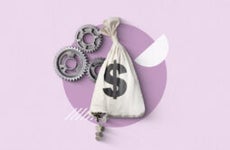Secured vs. unsecured personal loans: What you need to know

The Bankrate promise
At Bankrate we strive to help you make smarter financial decisions. While we adhere to strict , this post may contain references to products from our partners. Here's an explanation for .
Key takeaways
- Secured and unsecured loans can be obtained from a bank, credit union or online lender.
- Secured loans require collateral but can get you access to a larger sum of funds.
- Unsecured loans do not require collateral. The amount and rates you’re eligible for are based on your creditworthiness.
Personal loan shoppers will find two main categories: secured and unsecured personal loans. A secured loan is backed by collateral, meaning something you own can be seized by the bank if you default on the loan. An unsecured loan, on the other hand, does not require any form of collateral. Unsecured loans are the standard option among personal loan lenders.
Both types of personal loans have their pros and cons. But with so many lending options available, deciding the best option for you can be tricky. Gathering the facts about secured and unsecured loans is a great first step in obtaining a personal loan.
What is the difference between secured and unsecured loans?
Secured and unsecured personal loans differ in five areas: the need for collateral, interest rates, the amount you can borrow, how you can use the funds and what you need to qualify.
Collateral
The primary difference between secured and unsecured loans comes down to collateral. With a secured loan, you give the lender the right to seize the asset you use as collateral should you fail to repay the loan.
With an unsecured loan, no assets are required. But if you miss payments, your credit score will suffer (as it would if you default on a secured loan) and you will be pursued by collections.
How you can use the money
Most unsecured loans have few restrictions on how the money will be used. Prohibited uses typically include:
- Gambling.
- Buying securities.
- Illegal activities.
- Secondary education tuition.
Otherwise, you’re free to spend the money as you please. However, you must still tell the lender your intended loan purpose when applying.
With a secured loan, you may need to plan to use it in a specific way to be eligible. For example, OneMain Financial offers secured loans for vehicle purchases only. Their unsecured loans are more flexible.
Interest rates
Lenders take on less risk with secured loans since the borrower has more incentive to repay the loan. Because of this, average interest rates are typically much lower. Best Egg, which offers both loan types, claims its secured loan annual percentage rates average 20 percent lower than its unsecured loan rates.
However, with a good credit score, you can still get favorable rates for either type of loan. A good credit FICO score is 670 or higher, though lenders may have their own definitions.
Borrowing limits
Due to the financial approval requirements, secured loans tend to have higher borrowing limits, giving you access to more money.
You may still be able to get unsecured loans of up to $100,000 with lenders like SoFi. However, you will need to meet strict lending requirements.
Requirements to qualify
Some lenders may be willing to issue you an unsecured loan with bad credit. However, many lenders will decline your application or charge you higher rates and fees. You’re considered a riskier borrower.
With secured loans, on the other hand, credit requirements may be lower. The borrower offsets the lender’s risk by putting an asset on the line.
Pros and cons of secured and unsecured loans
When evaluating your options, it’s worth assessing the benefits and drawbacks of both secured and unsecured personal loans.
Pros and cons of secured loans

Pros
- Less stringent eligibility requirements.
- Often feature lower interest rates than unsecured loans.
- Higher borrowing limits than unsecured loans.

Cons
- Collateral can be taken if you default on the loan.
- Failure to repay the loan as agreed can damage your credit.
- There tend to be restrictions on how you can use the funds.
Pros and cons of unsecured loans

Pros
- A lender can’t take your assets if you default on the loan — though they may still sue you.
- No collateral required.
- Flexibility on how you can use the money.

Cons
- Often have higher interest rates than secured loans.
- It may be tough qualifying for them with bad credit.
- Defaulting on the loan can cause serious credit score damage.
Should you get an unsecured or secured loan?
Which loan type is better depends on your need, financial history and credit score. Since secured loans will often have lower interest rates and higher borrowing limits, they may be the best option if you’re confident about being able to make timely payments.
That said, an unsecured loan may be the best choice if you don’t want to place your assets at risk. Interest rates may be slightly higher, but they could still be competitive if you have good credit.
Both secured and unsecured personal loans have distinctive benefits and drawbacks. Regardless of which type of loan you choose, make sure to shop around with multiple lenders and compare their rates and fees to ensure that you’re getting the best rates for your financial need.
Related Articles


Personal loan vs. personal line of credit: What’s the difference?

